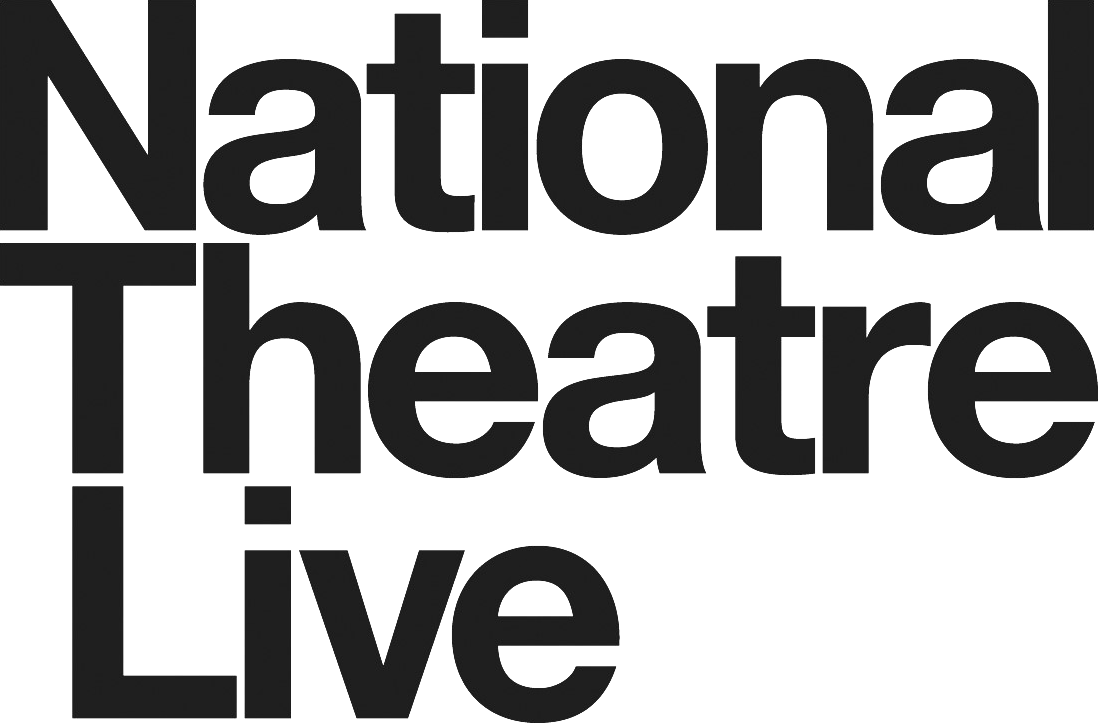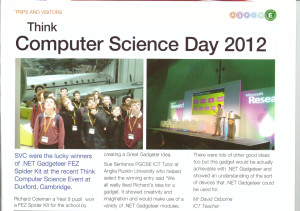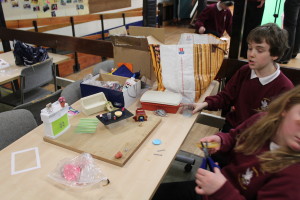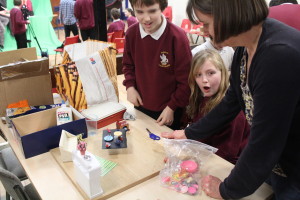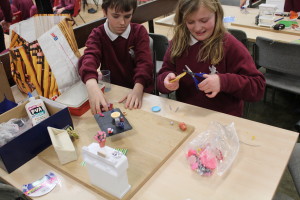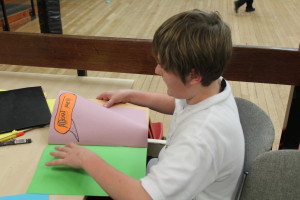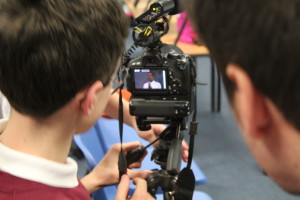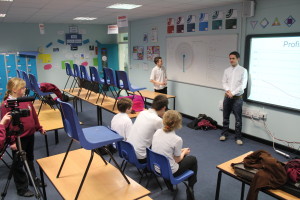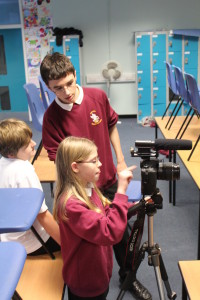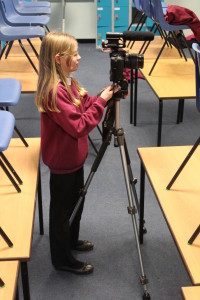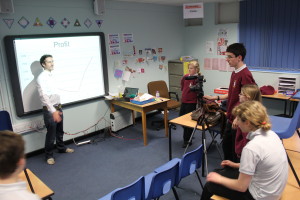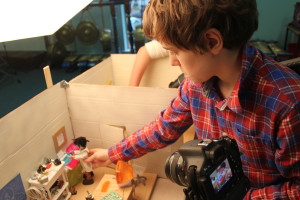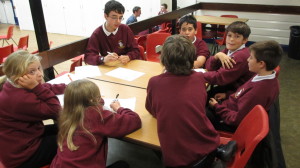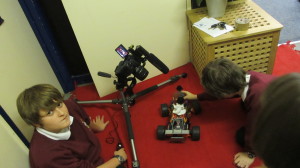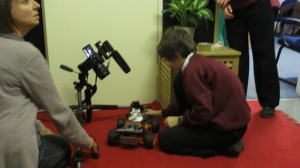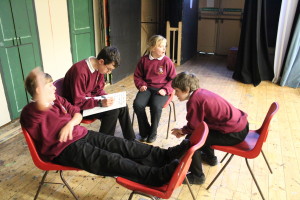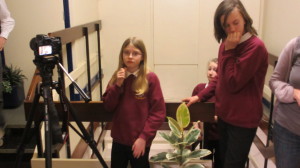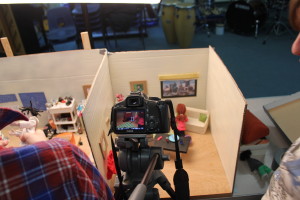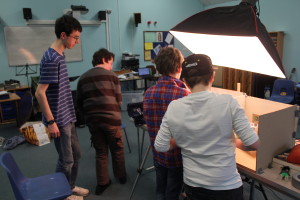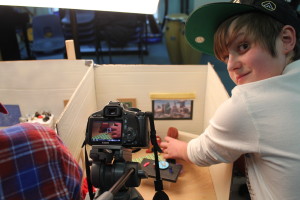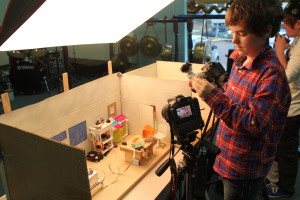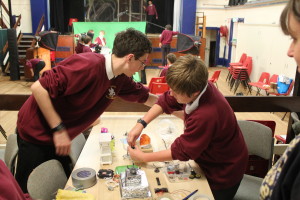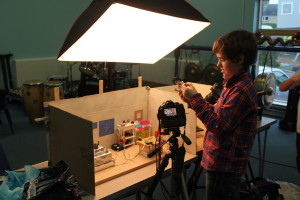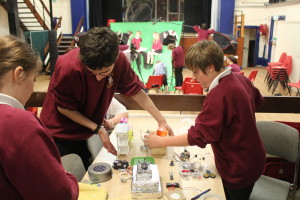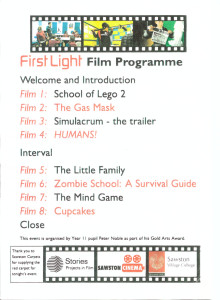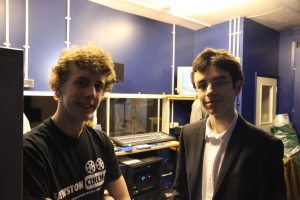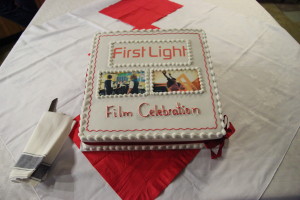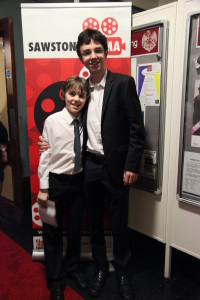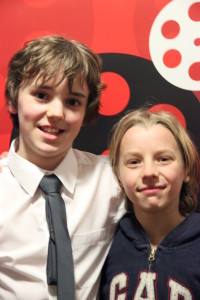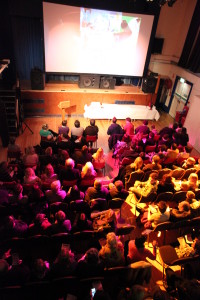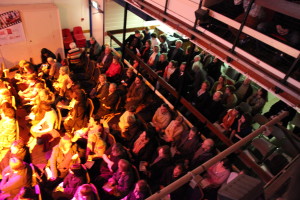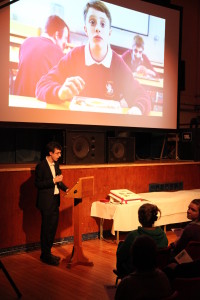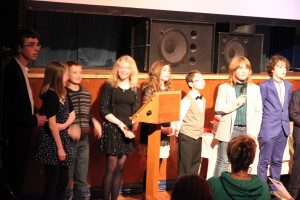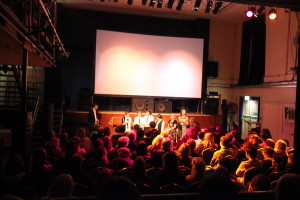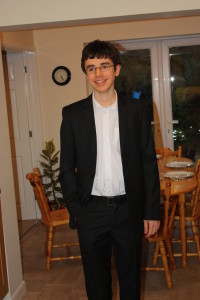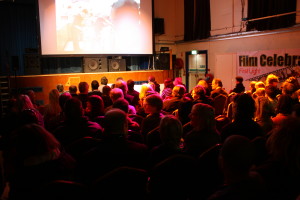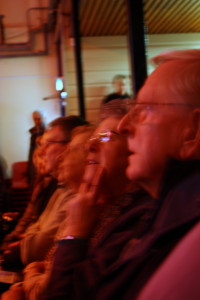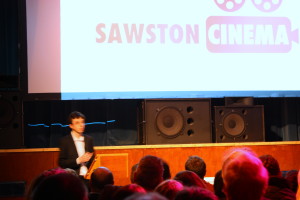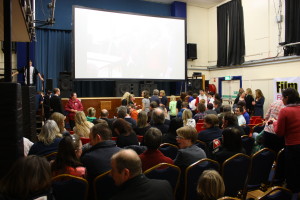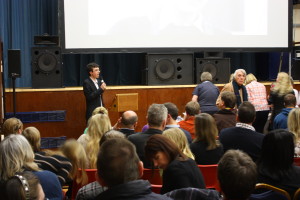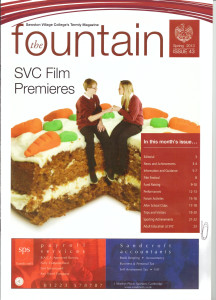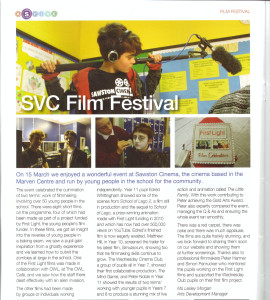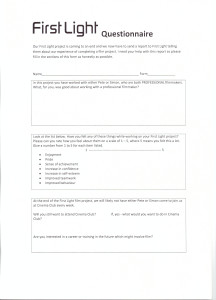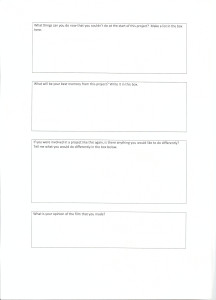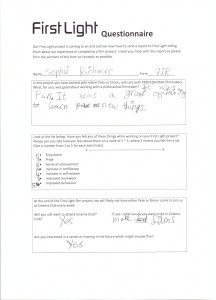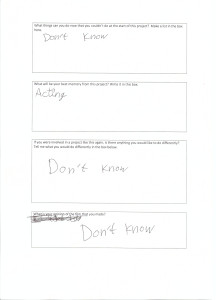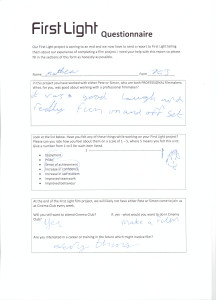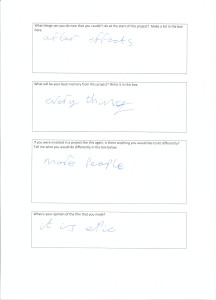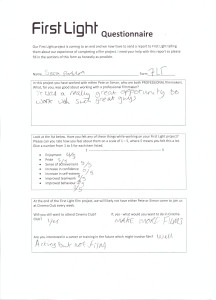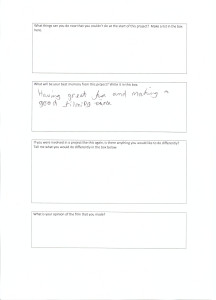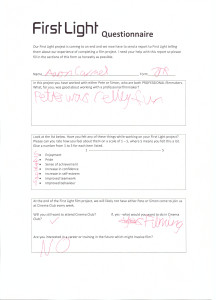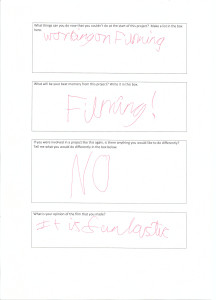Former Sawston Village College pupil Peter Noble has completed his Gold Arts Award. See what he focused on below.
Unit 1 PERSONAL ARTS DEVELOPMENT
Unit 1 Part A: Extend own Arts Practice
Original part A – interviewing technique: I completed this section near the beginning of doing this Arts Award but then redid it to better reflect the interests that have really taken off during the course of doing the other sections.
During the summer holidays a Summer School for Year 6 pupils moving up to Sawston Village College was held at the school. I volunteered to make a film about the week with the aim of it being shown on the Friday afternoon when the parents came to collect their children and see what they had been doing during the week. This meant that the film had to have a very quick turn around but without losing out on quality because of it. I was also helping at the animation workshop on Tuesday which meant that I didn’t have as much time filming that day, so any interviewing had to be done on other days. On the Thursday the only thing that I fully filmed was the last of the interviews because I then had to have enough time to edit all of the footage in the evening and get it ready for screening the following day.
One thing that I have always found difficult to get right is short documentary and event films. In order to help with this, I arranged to have a master class in interviewing techniques and sound recording from professional film-maker Pete Harmer while I was making the film. I wanted to do very short comments from lots of the children about their experience of the week. The plan had been to film them while they were working on writing up their Bronze Arts Awards on the Thursday afternoon. Once we were ready to go, however, we decided that it would actually be better to talk to them in pairs in the next door room so that it was a little bit quieter.
For recording the best sound Pete suggested that instead of using a lapel mic, like I had been doing up to that point, I should use a directional mic mounted on top of the camera. The reason for this is that because the camera was going to be very close to the subject anyway there shouldn’t be a lot of background noise, and it is much quicker to set up when you don’t have to worry about hiding the mic. It would also be better at picking up 2 people (we only had one lapel). Once the level was set on the first interview we didn’t have to change it for the rest of the interviews as they were all at a fairly consistent volume.
The style of filming Pete suggested was different to how I had been doing it previously. I had been setting up the camera on a tripod and sitting to one side of it while I asked them questions. For formal interviews with older and more confident interviewees and/or when the surroundings are particularly interesting or relevant, this would be a good setup but they were young and the environment wasn’t very interesting. The way that Pete suggested of doing it was to mount the camera and mic on a shoulder rig and kneel in front of the children and focus on them individually. For the purpose of demonstrating and allowing me to get used to the unfamiliar camera and lens I operated the camera, and Pete asked the questions. We used a very shallow depth of field like I had been using before but because we were focused much closer to the camera, the effects was even more pronounced resulting in a really nice look.
Below is a frame from the interviews that I was doing before
Below is a frame frame from the interviews done after
While editing I had to use interviews I had filmed earlier in the week with the ones filmed with Pete’s and I found that they often worked well to complement each other but a lot more was used from from the new interviews because the comments were a lot more usable. What I would have really liked to do is cut between during the same person talking but as we only filmed with one camera this wasn’t possible. When I next want to film interviews like this I might try to get someone to help me and have two cameras in the following arrangement which would allow me to get the best of both methods.
What I saw was that interviewing children can be very different to interviewing adults. They needed a lot more direction than adults and quite often found it harder to phrase things in ways that can easily be cut up and little sections used throughout film. In order to get round this Pete has a mental list of comments that he wants to collect at least once. These include:
- “I really enjoyed the week because…”
- “I have got to know new friends/Got to know people better”
- “I would definitely do something like this again in the future”
- “I feel more confident now because…”
- “My favourite bit of the week was…”
By using very specific, leading and short questions he was able to get much clearer answers that were much more usable for the final film. What also becomes clear very quickly is whether the interviewee is good at answering the questions and by shortening the interviews of those that weren’t so good we were able to get through even more. This definitely didn’t mean pushing out the really quiet children. In many cases it was clear that, although they were quiet, what they were saying was very meaningful. While editing I included something from everyone that we interviewed but only used the children whose answers had been particularly articulate to answer the harder question or the best remarks about the week and then I used the rest to answer the more general questions. This way of doing things also allowed us to get though a lot more of the children, meaning that more of them could be in the final film.
Another skill that I learned which I hadn’t expected to was how to make DVD menus. I normally publish work to either the internet (Vimeo or YouTube) or give the final film file to someone else to be added to other content which they then make a DVD for. Once all the children had gone we couldn’t continue interviewing so Pete showed me how to use Adobe Encore. It works by using layers (made using photoshop) which represent all the different elements of the menu. For example, the background is a layer that covers the plate and references a video or image file, the labels are text layers and the cursor is a series of small images next to each label. By putting groups of elements in folders and giving it a special prefix Encore will automatically know what you want that layer to do. For example, all the elements of a button would go in a file beginning “(+)” and a video thumbnail would begin with “(%)”. Once in Encore you just have to drag and drop connections between each part of the menu. Once this process is finished a .iso image file is made (a disk image which is not the same as a picture/photo) so the rest of the process is the same.
At the end of the week there was a screening of the film to the participants and their parents. The also took home a DVD with the film on and their animations (which I talk about in part B). Feedback completed by the week’s participants and their parents commented positively on the film. It was also clear that the children were pleased to have a record of the week and the parents had enjoyed getting an insight into what the children had been up to.
By looking in more detail at how Pete does his interviews and also looking more closely at interviews that are part of the media that I encounter everyday I feel that my work had become a lot more dynamic and interesting. At the same time I also this process has simplified how I use short comments from young people. My interviewing technique used to lead to long and complex answers that were difficult to divide into short clips to combine with other images but now I feel I can better get them to say what they would have said before but in a way that is a lot easier to use and produces a much better result.
Having done this I’m more aware of how an interview has been set up if I see one on the internet or the TV. I think that the way they are set up has evolved over the years from a more static image and often in a place with artificial light to more open, brightly lit and often with a camera that will slightly move. The change in lighting set up may just be due to advancing technology making it easier to deal with more varied lighting but I really like the more relaxed feel of interviews in naturally lit (or what looks like it’s naturally lit) and less formal settings for the kind of thing I make films about and so in the future I will try to shape my interviews to be more like this.
New Part A – VFX/Animation Residential
New Personal Arts Development
I chose to go to this residential to develop my effects work from having only worked on quite a narrow set of things and on my own to working on a much wider range of shots and within a group.
Through the BFI Academy I found out about this week long opportunity. I had to apply with some of the work I had already done (which comprised of some things from my Unit 2 and some other small experiments I’d been trying on my own). We then spent a week working on our own films, having master classes on a variety of topics and hearing from top industry speakers.
Introduction day
Along with all the admin things that had to be done on this day we did the following:
-Met as many people as quickly as possible to get a feel for who was interested in what
-Created a short stop motion animation piece
-Our film ideas were pitched and then we formed production teams of 3
The majority of the day was spent on the stop motion animation which, although it was very much like the animation workshops that I help at and so it I didn’t really learn anything about the animation, was still a really good opportunity to speak to people and find out what it was like to work with different people. The last thing that we did was to get into our production teams. Those who really wanted to make their film ideas had to get together people they wanted to work with and for those of us who really wanted to work on someone else’s film we had to organise this ourselves. This made it a lot more like putting together a real production crew rather than the film projects I’ve been in or helped at before where everyone moves around and leaders help a lot to find the right groups.
Before the week away
The idea that we wanted to achieve was very ambitious and we really wanted it to be done well and not rushed. In order to do this we decided that the shooting should be done in advance (which someone else in the group did) and I also looked into hair simulations and lighting from reference panorama to achieve realistic lighting. This meant that at the beginning of the week there was only 2 short blue screen shots to shoot.
BFI Film Residential Schedule
February 2014 – Saturday 22st – Sunday 16th
Residential Day 1 –
10:30am – 12:30pm Welcome CANDI
12:30pm – 1.15pm Lunch CANDI
1.15pm – 4pm Production Planning CANDI
4pm – 4.15pm Break CANDI
4.15pm – 5.30pm Production Planning CANDI
5.30pm Coach to Gilwell Park
7pm – 8pm Dinner Gilwell Park
8.30pm – 9pm Unpacking Gilwell Park
9pm Screenings of LIAF animations Gilwell Park
Residential Day 2 –
7.30am – 8.30am Breakfast Gilwell Park
9am Bus leaves for CANDI
10.00am – 12.30pm Skills training: choose 2 out of 5 rooms from Green screen, 3D animation room (Stop motion), Film making room, Sound recording/voice over room and After effects room CANDI
12.30pm -1.15pm Lunch CANDI
1.15pm – 4pm Continue skills training. Rooms, then begin production CANDI
4pm – 4.15pm Break CANDI
4.15pm – 5.30pm Production CANDI
5.30pm Coach back to Gilwell Park
7pm – 8pm Dinner Gilwell Park
8.30pm Intro to blogging. Options: films/board games etc Gilwell Park
Residential Day 3 –
7.30am – 8.30am Breakfast Gilwell Park
9am Bus leaves for CANDI
10.00am – 12.30pm Industry Speaker CANDI
12:30pm – 1.15pm Lunch CANDI
1.15pm – 3.30pm Production CANDI
3.30pm – 3.45pm Break
4pm Coach to Harry Potter Studios
6pm – 8.30pm Harry Potter Studios Tour Trip
8.30pm – 9.30pm Coach back to Gilwell Park
9.30pm Film screening Gilwell Park
Residential Day 4 –
7.30am – 8.30am Breakfast Gilwell Park
9am Bus leaves for CANDI
10.00am – 12.30pm Skills training: choose 3 out of 5 rooms from Green screen, 3D animation room (Stop motion), Film making room, Sound recording/voice over room and After effects room CANDI
12:30pm – 1.15pm Lunch CANDI
1.15pm – 4pm Production CANDI
4pm – 4.15pm Break CANDI
4.15pm – 5.30pm Production CANDI
5.30pm Coach back to Gilwell Park
7pm – 8pm Dinner Gilwell Park
8.30pm -10pm Industry Speaker Gilwell Park
Residential Day 5 –
7.30am – 8.30am Breakfast Gilwell Park
9am Bus leaves for CANDI
10.00am – 11.30pm Production CANDI
11:30pm – 11.45pm Break CANDI
11.45pm – 1.15pm Production/Post-Production CANDI
1.15pm – 2.15pm Break CANDI
2.15pm – 4.30pm Production/Post-Production CANDI
4.30pm – 4.45pm Break CANDI
4.45pm – 5.30pm Post-Production CANDI
5.30pm Coach back to Gilwell Park
7pm – 8pm Dinner Gilwell Park
8.30pm -10pm Industry Speaker Gilwell Park
Residential Day 6 –
7.30am – 8.30am Breakfast Gilwell Park
9am Bus leaves for CANDI
10.00am – 11.30pm Post-Production CANDI
11:30pm – 11.45pm Break CANDI
11.45pm – 1.15pm Post-Prodcution CANDI
1.15pm – 2.15pm Break CANDI
2.15pm – 4.00pm Post-Production CANDI
4.00pm – 4.15pm Break CANDI
4.15pm – 5.30pm Post-Production CANDI
5.30pm Coach back to Gilwell Park
7pm – 10pm Last night feast- BBQ, campfire and live band Gilwell Park
Residential Day 7 –
7.30am – 8.30am Breakfast Gilwell Park
9am Bus leaves for CANDI
10.00am – 12.00pm Q&A: What happens next? CANDI
12:00pm – 12.15pm Break CANDI
12.15pm – 1.15pm Screening CANDI
1.15pm – 2.15pm Lunch CANDI
2.15pm – 3.00pm Evaluation Session/Goodbyes CANDI
Day 1
-Quite a slow start due to admin things but we got to watch the mentors showreels which were surprisingly mixed. The animators showreels were a mixture of finished and unfinished looking work but it was clear that the animations in all the shots was good. The filmmakers and cinematographers showreels where the ones that surprised me because although there were things that looked really good they had also included things that looked quite amateur or messy in comparison.
-We were then grouped so that each production team of 3 was with 3 other production teams lead by one mentor. Our mentor was a freelance filmmaker.
-He spent quite a lot of time going over very basic filmmaking and urging us to do more storyboarding. For the other groups this may have been really helpful but the group that I was in all had enough filmmaking experience for this to not be useful and we had already thoroughly storyboarded and shot our film.
-In the afternoon we were given a chance to catch up on the progress made by each of use in the weeks leading up to the course and we decided on some short term deadlines for our projects.
Day 2
-For the first 2.30 today we picked 2 training sessions to go to.
-The first was an introduction to 3DS Max which was useful because even though I’m quite familiar with 3D software I’ve never properly used 3DS Max and it’s used more in the industry than the software I have been learning. It was also a small group so the tutor was able to keep us all moving along at our own speeds which was really good.
-The second sessions was green screen which wasn’t so useful as it was mostly focused on the chroma keying in After Effects which I have used before in more complex ways that we were using. The one really big advantage of this was to see all their lightings and blue/green screens so I knew what they had for when we needed to shot our shots there.
-The afternoon was GREAT. We were left to begin working in our groups on our films. I’ve never worked with people with around my level of experience and enthusiasm before. I mainly worked on the titles which were animated 3D text, animated lighting and a background cloth simulation.
-We spent most of the evening continuing to work on the shots and a 3D monster.
Day 3
-In the morning a senior animator from Framestore came to give a talk about how he got to where he is, the work he had done on Gravity and the overall process of making Gravity. He explained how the shots were broken up into departments and then different artists within a department and how many things were done all in parallel to speed up the process. For example, in one of the shots he was animating the character in the foreground while a junior animator was working on the character in the background at the same time as the FX department were developing the techniques for smashing a part of the ship in a believable way behind the characters. I also went and spoke to him after his talk and asked him about roles involving computing skills as well as creative decisions. He said that in a company like Framestore most people have very specific roles which they can’t move away from. However, technical directors coordinate the technical development and the artists so there is some overlap for them.
-The rest of the morning and early afternoon was spent working on our films.
-In the evening we went to Harry Potter Studios. Although I have been before I really enjoyed seeing the planning and art work for the film. Hundreds and hundreds of architectural drawings had been made for all the buildings in the film, little models had been made of all of the main buildings and locations in the film and for many of the scenes and characters there was full colour paintings. Many of the paintings looked different to what is actually in the film but it was clear that the style and/or feel of the creatures in the paintings had been carried through even though details were changed later in the process. I find it fascinating to see how the ideas for creatures and places that don’t exist are formed, developed and then finally created with a computer.
Day 4
-All day was spent on our films. I found a free model of a fighter jet. I spent the rest of the day rigging, animating and lighting it as well as looking into getting animated camera data from blender to After Effects.
-In the evening one of the organisers from the London International Animation Festival came to talk about the festival and show us some films. He showed us a range of films but of all of them I think I actually enjoyed the children’s section most because a lot of the other sections were very abstract and didn’t have a clear meaning. Within the children’s section there were films for very young children but the ones that I enjoyed were aimed at a higher age group and were often very funny with clever twists on things we are all familiar with.
Day 5
-All day spent working on our film. At this point we were concerned about getting the 3D character finished. We had several technical issues which set us back and the modeler was also very keen to use a high level of detail which was great except it had been left too late. By the end of the day the creature was just about read to animate.
Day 6
-All day on our films again. The 3D creatures rig had to be finished, then it had to be animated and then everything had to be rendered and composited. The original plan was to cover the creature in short hair but this didn’t happen in the end because there wasn’t time. While waiting for the creature to be finished I prepared everything for the final render and did the last fighter jet shot.
-The film was being rendered at midnight!
Day 7
-In the morning 3 speakers came to talk about how they worked on a day to day basis. One was a traditional animator who had worked on a lot of documentaries, one was a texture artist who had worked on films like John Carter and Day Z, and the last was the owner and compositor for a small company working on a variety of projects. It was very interesting to hear them talk about things like how they balance their working life with life at home (try not to take work home!) and how they got to where they are (get your foot in the door and then you’re on your way). After the talk I went and asked the company owner/compositor a similar set of questions to what I asked the animator from Framestore. The reply was very different! He said that a lot of people with a mixture of computing and creative skills are taken up by larger companies to be technical directors and similar roles which means that for all the smaller companies there are very very few people with that skill set. Another things that he said is that there are so many people who teach themselves to use the software that this is no longer highly prized on its own. He thought that a good way to get started for someone like me is to get into a good position within a company with my computing and science skills but still showing an interest in the creative side at the same time as practising my creative side on my own so that I can then move into a role somewhere in between the two.
-All the films that had been made that week were then screened. Because of the wide range of abilities going into the course there were a wide range of films. I was glad to see that, although there were a couple of films that looked a little more polished than ours, ours was the most ambitious and complex but we had still managed to pull it off convincingly.
The film: Five More Minutes
Feedback
“Dear All,
I hope you all arrived safe and sound back to your homes last Saturday afternoon.
I wanted to congratulate everybody for the amazing work produced. The films are all fantastic and I’m sure you all learned new skills and made some new friends.
Best wishes,
Tatiana”
Shortly after we got home the following feedback was sent by two of the professional artists that watched them:
“My name is Amanda Bone and I am Texture Artist currently working at Passion Pictures. Its my
job to add the colours and texture to CG models for Film and advertising. I have been in the film
industry for over 10 years and I starting out working in a costume/prop shop in the holidays.
I was very impressed with the level of work done in such a short amount of time, everyone
should be proud of what they achieved and I hope you have a bright future in the industry.
[…]
5 More Minutes
Great concept, well framed and paced. Great work for such a short amount of time and
genuinely funny. Technically accomplished with good effects comp’ing
[…]
Things to consider:
Only put your best work on your reel, there is no need to fill it out with second rate work.I have noticed some people have drawn out their videos to make them longer. This is not necessary, short and sweet is fine. You often have a very short amount of time to make an impression on people.
Try not use ‘Serif’ed’ Fonts unless its classical, as it has certain general expectations attached to it. Try to avoid using cliche fonts such as Times New Roman and comic sans.
Create a web site, there are plenty of free hosts out there, keep it crisp and simple. A recruiter might skip your site if it take too long to open.
Create a showreel (video of your work) and put it online on a site such as Vimeo. Also upload a flash/html5 version so you can embed it on your web site.
School marks are not the most important thing but they help. Consider even the most boring lesson a means to an ends! School is tough and can seem like it stifles your creativity, but try to keep your eye on the prize and you should make it through.
THE PUB (for those old enough to drink), take time to socialize with your peers. All work and no play will burn you out and you never know when your make an important connection! Use websites such as LinkedIn and connect with everyone you work with especially recruiters. Networking is really important. Use social networks such a Facebook and twitter to keep an eye on the companies you may wish to work for. This is very important, it is a very competitive industry, most companies will advertise through social media instead of their website. My current job was posted by a recruiter on LinkedIn and before that I heard from a friend a company was recruiting.
Be diverse and learn as many different programs and disciplines as possible, you never know when a skill might keep you in work when a project ends.
Most of the big companies like you to have traditional art skills if you are considering vfx. Try keeping a sketchbook at hand to doodle ideas. Be proactive and create your own projects and art work. Build a portfolio that is relevant to you.
Dream big and go beyond those that have come before you.”
Maria M from Passion Pictures
[…]
5 More Minutes Really enjoyable, and a good concept and story really well told. I would have loved to have seen what the guys would have done with another week, as they would have probably had time to add some more detail to the Monster, the boy’s toy. But despite this they really pulled it off, great soundtrack too. Apart from the call to the boy for lunch, if only that had been projected/shouted as a line of dialogue. The ending and pay off was great, and much stronger and funnier to not go back to fantasy too, and instead stay with the boy in his bedroom.
[…]
Review
This week away was a really intensive development of my effects work into a larger range and working as a team. We took on too big a challenge to complete in a really polished way in the time we had but I’m really glad we did because it really pushed me to develop the way I work and will hopefully mean that when I get a shot where I do have enough time I’m able to not just finish it but finish it to a really high quality because I know how to efficiently put the main building blocks of the shot together.
I’ve made contacts with people my own age with a similar interest and in the next few months the BFI are going to try and organise a work placement or if that’s not possible a visit to a visual effects company. These are contacts and experiences I would really have struggled to get on my own and will help to shape the way I work and hopefully make me a more accomplished artist.
Part B: Identify and use Development Opportunities and Sources of Information within the wider Arts Sector
Helping at workshops
Something that several of the professional filmmakers that I personally know do is run workshops for young people to teach them and get them excited about filmmaking. Recently I have had the opportunity to help at two different kinds of workshop. The first was an animation workshop where each participant makes a super hero and then they battle in an arena. For this I was supervising at one of the stations where the children were animating. The second was a workshop making a short film in a day. The filmmaker who ran this workshop wasn’t able to edit the film so I helped shoot the film on the day and then edited it before the end of the week so that the parents could see the film when they picked up their children on the Friday.
In Year 8 I was a participant in a project where we made a lego animation which introduced me to animation. Since then I have helped other students who were trying to make their own animations so when the super hero animation workshop came up and the filmmaker needed some helpers he knew I had done it before. What I was doing involved generally supervising while they were drawing and modeling their characters (and making sure they would be able to stand up on their own when being animated) and then when they were animating there were three different stations set up each with someone to teach them how to operate the software and to advise on the animation. These workshops have been run many times before and are very successful so it was really interesting to see how the organisation worked.
Because the workshop only takes one short day with lunch and breaks there really isn’t much time. Despite being an animation workshop a lot of time is also given to the designing and building of the characters. However, this works really well because with the right people supervising each group they are able to make a finished (if only very short) animation but they learn how it works and they were all really proud of their heroes and have a really good model to take home. Many of the people who move up to Cinema Club when they join the school in Year 7 have been on this workshop (or another run by the same filmmaker) and it got them really excited about film. I think that this is by far the best thing about these workshops because I know a lot of the introduction to filmmaking type talks/workshops focus so much on splitting everyone into roles (director/camera/sound/actors) that it makes filmmaking seem really rigid and boring. Although knowing about those things is important for people who really want to get into filmmaking, for most people filmmaking is just a hobby and it should be as fun, fast paced and creative as possible which is exactly the feel these workshops have.
From my project with young people (Unit 2) I know that it can be really stressful trying to make a really good film with younger people but the way to get the most from it is to be as flexible, calm and not too controlling of what they are doing but at the same time have control over the general direction of everything. This is something that the filmmaker running this workshop is REALLY good at. Instead of driving the children to making the most technically perfect film they can in such a short time he guides them through the process of making and animating their characters. This means that although the films are very short and not technically perfect they are really fun because everyone had fun making them and the participants feel a sense of achievement in what they have achieved.
The second film workshop that I helped at and then edited was very different in both style and content but also had a lot to offer to the participants. They shot a film in a day from an idea that the filmmaker had already decided on and concentrated more on the actors and crew on set. By deciding on the idea before hand I don’t think the participant felt like it was their film as much but the filmmaker had left a lot of room for adding details to the film (which they did very happily!) to make it more their own. The advantage of this was they he had chosen something that was achievable during the day, was flexible in the number of people it could include, reduced the long planning process and allowed time for learning about camera/sound/directing.
To begin with a cycle was set up with a camera, a sound, a directing and acting stations to let everyone have a go. At the same time he explained about the series of events that happen to do a take. This was followed by a discussion about things they wanted to add to the film and where the main shots of the film would take place. What was really nice to see is that they were all really keen to add a storyline to the film (the pre decided idea was just based around a series of effects shots without any real story). I have been leading/helping at Sawston Cinema for some time now and it can be frustrating when groups get caught up on individual shots/effects and they don’t concentrate on the story (which at the end of the day is the whole point of making a fictional film) so I think it really helped them concentrate on the story when the style and effects were already decided.
Although I have just said that I don’t agree with teaching film to complete beginners by breaking things into roles and then telling participant how it works, this workshop worked well because they got to put those roles into action and the crazy and fun idea meant that they really enjoyed it at the same time.I think that the animation workshop would be better for slightly younger children and for getting them really enthusiastic and the second workshop I think would be better for getting a more accurate impression of what filmmaking is like or for people who are already interested and looking to try a bit more of it. With the technology available to everyone at home both of the activities in these workshops could be done at home but the best things about these workshops are the guidance from the filmmakers to improve what the participants are doing and being able to do it alongside a group of people their age having just as much fun.
Another completely different workshop that I helped at was for sound editing. As part of a BFI course I had been a participant at a sound workshop. Shortly after we asked the practitioner who led this if he would do a workshop at Sawston Cinema and I helped him when he came to do that. After this he contacted me to see if I would help at another workshop he was doing for a summer school. I went to this and was helping with the operation of the software that they were using. It was a bit of software that I had never used before so I had to learn how to use it before starting but I had seen him use it before and most software for sound or video editing works in a very similar way. The workshops were all based around completely remaking the soundtrack for a short clip of a film or animation. This works really well because it involves lots of foley and can also involve software or recorded instruments as well. Although I don’t want to work in sound design, sound recording or composing I still found it interesting to learn a bit about it because sound is such a crucial part of film and because without an engaging soundtrack visual effects (which is what I’m really interested in) become very unrealistic.
BFI Film Academy
This was a course made up of 5 weeks worth of Saturdays and some other activities in between. Three of these activities (The Last King of Scotland, visit to Pinewood and the online seminars) are described in Part C) and I met the filmmaker who then ran the day of filming for the workshop in the section above.
The main part of these Saturdays was master classes covering the whole of the filmmaking process from the point of having ideas until distribution and screenings. These were really good for formalising and filling in gaps in what I already knew because my experience of filmmaking was from the perspective of a very small crew where everyone was multitasking.
Everyone else on the course was completing a silver arts award (I’d already done one) and for one of the sections everyone was put into groups to make a film. Everyone was given a very specific role but mine was sound recording and the director decided that the only sound was going to be music so I ended up helping with a bit of everything as my experience with Cinema Club meant that I had the most experience of actually shooting a film. We borrowed a camera and I brought mine as well but no one in the group had used a DSLR for filmmaking before so a lot of the assisting I did was related to the cameras.
The Cambridgeshire Film Consortium
This organisation was the one running the film academy but this was only one of many things that it does. It is a partnership between Anglia Ruskin University, the Cambridge Arts Picturehouse, Parkside Federation and Long Road Sixth Form College and they aim to deliver activities for students and the community to educate them in film. This can range from screenings of films people would be unlikely to be exposed to otherwise or it could be introducing children to film making. They also run larger projects with funding from places like IntoFilm (http://www.intofilm.org/ – formerly FirstLight) and Heritage Lottery Fund (http://www.hlf.org.uk/Pages/Home.aspx)
http://www.cambridgeshirefilmconsortium.org/
Sawston Cinema Screenings
At Sawston Cinema there is a screening of a film roughly every month and more recently we have been able to live stream shows from the National Theatre. The other event that happens regularly is that at the end of each year there is an event where the films that the students have been working on are premiered. Since I have been in Year 7 I have been going to these screenings (I’ve only missed a couple in nearly 6 years!) as a projectionist. This involves unpacking and setting up the projector, aligning the image with the screen (which is never in exactly the same place as it’s on a stand, turning on and testing the sound system and starting the film when everyone is ready. I first joined the cinema project when it started when I was in Year 7 and I went to the arts picture house where they explained the running of a cinema and what our role as projectionist would be. The cinema has also been used for screenings in school time which I was eventually able to help with on my own. I was also able to assist with the training of the next generation of projectionists.
Feedback
I have led some of the film-making workshops which Peter has supported. It has been really pleasing to see Peter’s progress from a Year 7 pupil interested in filmmaking to someone I can now rely on to work with me in workshops. Peter has excellent technical skills and knowledge, and works well with younger people. Even today, I still rely on him as a leader at the Cinema Club at Sawston Village College, and I know that I can leave him with a group of younger pupils and that they will be well-taught and supported in their filmmaking.
I was also the Cinematography tutor on the BFI Film Academy which Peter attended. He was an attentive and focused student on this course, both keen to learn and to share his skills with others. I wish Peter great things for the future.
Peter Harmer
I am the projectionist at Sawston Cinema. Peter has been involved with this cinema since we opened in 2008 and has, to date, attended nearly every screening. Peter enjoys working in projection and understands all the technical aspects of this. He has on occasion been alone in the projection box and managed screenings for primary school children and during Summer Schools. This has never been a problem for him. He works well under pressure and has been excellent at sharing the skills and knowledge he has with others.
Steve Williams
Part C: Research and Review the work of more Advanced Practitioners and Explore the Relationship to Own Practice
Anifest
After a film that I was involved in was successful enough to be picked to be screened at Anifest 2012 in Teplice, in the Czech Republic we were able to go and not only see our films but also see many other films. There was a very wide range of films screened and we also met with Barry Purves who makes his living from animation and running festivals like Anifest. We met him by accident in a cafe and he agreed to answering a few of our questions while we recorded it. We recorded all throughout our trip and then put together a short film of our whole experience at the end.
We got to see lots of films there that were very unusual compared to what I was used. There were some very abstract, spooky and/or extremely slow and pensive. I think that it was a good experience to see these films but I think that they were aimed at older people with a deeper understanding of the world and more experiences to be able to make emotional links with the films. Because of this the films that I really enjoyed were the ones that were short, snappy and with a really clear, cleverly put and/or funny idea. The one that I always remember is one where all you can see are footprints and they all start different but as the film goes on more and more of them wear the same shoes and march in time until there is only one left running away… until he’s made to wear shoes and march in the group as well. I thought it was clever and simple but at the same time was telling a story that is very true for many people.
“Think Computer Science” Youth Conference
In 2012 I went to this conference aimed at young people wanting to go into research or computer science. The actual effect for me was to set of a real hope that I could go into a creative industry. This is because there were two speakers there who were both qualified in computer science but were working in a creative industry. One was a games developer and the other was head of 3D at a visual effects company. It was the second speaker, called Gavin Graham, that really encouraged me to look into visual effects. At the end of the event I managed to get a couple of minutes before the bus left to speak to him. He emphasised the importance of maths, physics and computing and said that of all the things that helped him nothing was as important as a good foundation in these things.
I still think that the path Gavin Graham from Double Negative took is what I want to follow. I don’t know how old he was but he was much younger than I expected for the head of one of the biggest departments in one of the world leading visual effects companies working on the very best new films. He demonstrated that the choice doesn’t have to be between technical and creative so this path allows me to be interested in more academic subjects as well being creative.
The following summary of the event is taken from a newsletter
“On the 11th December 2012 the two computer science classes went to the Duxford Imperial War Museum for Microsoft Research’s Think Computer Science event. The day started off with Professor Christopher Bishop of Microsoft Research giving a talk entitled “What is Computer Science?” At the beginning of the talk he demonstrated how fast a computer processor was with the help of County High’s Charles Yallop. Charles and another volunteer held a length of tube lined with RDX explosive; Chris Bishop then lit the end of the explosive tube and the audience keenly swallowed the sight of the flame travelling along the tube “faster than the speed of sound”. Christopher then announced that by the time the flame had travelled the distance equivalent to the width of a human hair, an average laptop could have calculated the result of 3.141592653589793 x 2.7182818284590452 ten times over! He continued his talk with the explanation about how and why many academic fields are necessary for computer science, where we see computer science in our everyday lives, and then he linked this all on to the development of Microsoft’s Xbox Kinect and how technology like it could have many practical applications in a vast amount of different professions.
Following on from Christopher Bishop was Heidy Khlaaf who talked about what computer science meant to her and how she pursued a career at Microsoft Research, going against her family’s wishes for her and taking active decisions in her learning journey in a brief but personal speech.
After a short refreshment break we were back into our seats to listen to a talk from Nick Adams who works at Blitz Game Studios. His talk described the development of the Xbox Kinect game “Puss in Boots” and how he and his team at Blitz Game Studios overcame the difficulties which the making of the game presented. His talk also enlisted the necessities of video games and their development, talking about how the game character has to be brave and heroic and thus make the player feel brave and heroic (egocentric bias) and going on to explain the importance of testing games thoroughly and frequently between each stage of development.
Next, it was lunchtime, and we were free to roam about the museum and go to the computer science demonstrations and workshops which had been set up around the venue. In one place, there was a ‘Gadgeteer’ workshop where I and a group of friends built and programmed a camera. One of the other demonstrations which we visited was the NUIverse demo, where we were shown a touch screen table. This table was designed for exploring “natural user interaction with a large, multi-dimensional dataset”; on the table was a virtual version of our Solar System which could be navigated through with just movements of your hands.
After the lunch break, we sat back down into our seats for the last talk – and, perhaps, the most interesting one. The talk was from Gavin Graham from Double Negative Visual Effects and he described his job as the Head of 3D effects for the company. He talked about how the company develops their effects with its own software and he also gave us a taste of some of the films and scenes which he and DNVE had worked on… from working on action-adventure films like Iron Man, Harry Potter and Skyfall, to science-fiction films such as Inception and Paul, it was evident that Double Negative was a leading company in the world of visual effects.”
Online Seminars
These were run as part of a regional BFI film academy and covered 5 different topics. There were Writing for the Screen, A Guide to Making Short Films, Working in Visual Effects, How to Find a Job in TV and The Role of the 1st Assistant Director. Each one contains some time talking about what they are involved in, how they got into the industry and what we should be doing to help ourselves get into the industry. Before each began and as they were going we could post questions to be put to the speakers.
I found the VFX one particularly interesting. The speaker was able to give a great insite into what it is like to work in roles in real companies. He also talked a little bit about showreels and CVs. He didn’t talk so much about putting them together but about how important it was to get them seen. The best way to do this is to put together a very short showreel of your best work and then find as many people as you can to send it round to. This means that for those of us who are too young to be looking for employment at the moment we can be thinking about a showreel and collecting anything which might look good on one. When asked about technology and what to learn he commented on how fast the technology was evolving. This means that even if you can use the latest 3D or compositing package now it will almost certainly have been replaced or significantly improved by the time we are looking to get jobs. He said that the best thing for us is to learn the fundamentals of the technology, lighting and compositing (possibly by learning the specific packages but paying attention to how they actually work). A book that was suggested as a really good place to start and is considered by the industry to be the knowledge that underpins all compositing was “The art and science of digital compositing”. I bought myself a copy of this book and although it is a really difficult read, due to it being so dense, it has proved a really useful insight into everything from what is really happening on a pixel by pixel level right up to the creative decisions what matching lighting.
The Last King of Scotland
As part of the BFI film academy there was a screening of “The Last King of Scotland” and then at the end there was a panel that we could ask questions. The panel included the head of production and the co-producer. They spoke mostly about the administrative aspect of the film (as that’s what their job deals with) but even though this isn’t really the aspect of film I’m interested in it was still interesting to hear them talk about the location shooting and the kinds of things they had to get/organise to support the filmmakers.
I’m now absolutely certain that I’m not aiming to be in this aspect of filmmaking because when they were talking about all the things that they were organising at the same time I couldn’t help thinking that I would find it frustrating to be doing so much for the film and yet have no direct influence on it (and I don’t think I could manage to think about that many things at once!).
Pinewood Visit
As part of the BFI Academy we visited Pinewood Studios and had a tour of their facilities. I was really surprised that in order to cater for all types of film they have to have basically empty warehouses so that they can be changed to meet any needs. An example of this is the set used for a James Bond film where there is a submarine in a docking area. When a set it was a military dock full of people, vehicles and structures all round the walls but when we saw it it is just a huge empty warehouse with a large rectangular hole in the ground. The scale on which these productions work was amazing.
Pinewood also has special facilities for underwater shooting with both indoor and outdoor tanks. There were also television studios which were much smaller and looked much more like how I expected a studio space to look. This is because of the lower budget and shorter production times of TV programs means that they can’t construct the huge sets that films do.
University Courses
After talking to many different industry professionals at all the events mentioned in all the parts of this Gold Arts Award and looking at where their education has lead them and how closely that fits with what I would like to be doing I’ve decided that the best way forward is to study a computer science degree. I made a similar decision for A levels to do all academic subjects with the intention of moving back towards the arts at a higher level. Another reason that I decided to go the computer science route is that the arts are much more accessible outside a formal education than computer science is. Opportunities like the BFI academy and residential will allow me to keep developing creatively. Another reason is that an older student at Sawston has gone to study film at university and the feedback from him is that although the experience is fantastic he isn’t learning as much as most people because we had such fantastic support from Peter Harmer (professional filmmaker at Sawston). Many universities offer modules relating to graphics, computer vision and simulation.
I’ve also been looking at schemes like these:
http://www.moving-picture.com/join-us/internships/mpc-film-first-step-2014
In this particular example they take university students for 8 weeks in the summer for a placement and then attach them to a mentor who guides them through their last years at university to help guide them on making decisions about what to focus on. If everything goes well they will also offer a junior position at the company when they interns finish. Most of the disciplines advertised are purely for artists there are a few aimed more at technicians which would be the place I would have to start with a computer science degree. From there it seems to be very common for people to take on Technical director roles where they have varying degrees of creative and technical tasks. This allows them to decide which one they want to be doing or find a balance of doing both.
Part D: Form and Communicate a View on Issues of Concern that Affect their Art Form Sector
“visual effects is not about pixels, but people” – Life After Pi
-The VFX industry and why the way in may not be as narrow as you may think
Edit: I have changed the title (the old one remains below the new one) for reasons that will become clear by the end of the article and in tribute to the amazing work of artists round the world in difficulty because of the structure of the industry.
Visual effects is the manipulation or creation of imagery using a computer. Visual effects shots might be done because it isn’t possible to actually shoot (eg UFOs), it would be too expensive to achieve (eg blowing up a skyscraper), it could put an actor in danger (eg stunt shots) or to clean up objects that don’t fit in the film (eg pylons in a medieval landscape). Visual effects can be very obvious (eg transformers) but can also be used without ever being noticed (eg period drama).
The recent troubles of many large visual effects companies may make it seem to young filmmakers like it’s an impossible industry to get into. I have tried to gather together an overview of what the industry looks like at the moment, what I can do and what is being done to help aspiring VFX artists like me.
The visual effects industry is made up of “houses” ranging from 3 or 4 artists to international companies with thousands of employees and independent artists. In more recent years a lot of VFX houses have adopted the model (which is now widely used in large film studios) of employing freelance artists on short term contracts based around each of their projects. This allows them to bring in just as many people as they need and they can grow rapidly if needed. Many of the worlds leading effects companies are based in London UK (eg MPC and The Mill) but there are also large ones around the world including in Europe, the US and New Zealand. There is also a growing industry in Asia but at the moment although they may offer cheaper services they can’t compete with the level of quality from others.
One thing that has encouraged the growth of the industry in the UK and which is continuing to make it a popular location for post production is the tax breaks that are offered for film and TV making it more cost effective. This also applies to large studios (like Pinewood) meaning that it is possible to base a whole in the UK.
In the last year Digital Domain Media Group submitted a bankruptcy filing after it was unable to pay back debts. To many this came as a surprise because the studio has worked on some of the biggest VFX films to date, won 7 Academy Awards, been nominated for 5 more as well as winning several BAFTA awards. The company has also won countless awards for its television and advertising work. The company has come under new leadership (now under the name of Digital Domain 3.0) and has continued working but has had to close some of it’s start up studios and hundreds of jobs have been lost in the process. Since this trouble Digital Domain has been working on “Ender’s game” which they owned a large portion of. For a lot of VFX companies at the moment this is unusual because they are often only paid a fixed amount per project. This means that even if the film makes a huge profit the VFX houses rarely see a substantial benefit. There has also been worry that due to competition from cheaper houses the larger ones are having to drive down costs to the point where they aren’t making and profits.
Recently there has been a lot of concern over the well being of artists because it can be too easy for them to be unintentionally mistreated by a struggling company. Like many industries the security of peoples jobs makes it harder to join and the film industry has the added complication of it’s reputation for being notoriously difficult to break into. However, the continually growing demand means that there are plenty of places recruiting which is helping. In addition to this the BFI (British Film Institute), supported by the National Lottery and the government, are investing around 500 million to increase growth and education in the film industry. Around 44 million per year of that is going towards education and one of the initiatives set up by this is the BFI film Academies. I am personally involved with and have benefited from this scheme and so can say from experience that it is really making a difference for young people just beginning to explore film, looking for a way to progress or looking for a path into the industry.
In the UK the VFX industry has not run into as much trouble as many companies in America and, thanks to strong support for education and the fantastic work on UK artists, the industry is continuing to grow. As of March 2013 UK VFX was estimated to be worth 375 million. So what does this all mean? Although some places have run into hard times the UK is generally still growing and in order to grow they need new people which is great news for young people like myself who would like to work in this industry. It may still be hard to get into but, despite the impression that things are headed down hill, everything any young person might need to start is being provided.
EDIT: After writing this a short documentary was released called “Life After Pi”. It really opened my eyes to just how far the industry has to go and how things that may be appearing to help may be making it worse for some people. Rhythm and Hues won an Oscar… 11 days after going bankrupt… when accepting the award recognition was being given to the difficulties the VFX industry was facing… their microphone was turned off. The visual effects artists are almost always the last to be shown on the credits of a film. VFX houses get paid a fixed amount… even if they end up doing more work… and they don’t share in any profit a film may make. Studios chase tax breaks around the world are meaning artists have to travel away from their homes or lose their jobs. This doesn’t strike me as being a sustainable way of making outstanding visual effects.
I think that at the moment we are very well off in the UK but it may not stay the same and this isn’t fair on all the incredible artists around the world who suffer because of this.
On March 2nd 2014 and protest march was held near the venue for the OSCARS to raise awareness of the difficulties there are in the industry because of subsidies in other countries. They are keen to make it clear that they’re not trying to make their countries the only place where VFX is done. They want there to be a level playing field, unaffected by subsidies, on which work is awarded by the merit of the VFX houses and not on how much governments will pay the studios for bringing work to their country.
“visual effects is not about pixels, but people” – Life After Pi
http://www.youtube.com/watch?v=9lcB9u-9mVE
http://www.fxguide.com/quicktakes/adapt-releases-first-video/
http://cinefex.com/blog/life-after-pi-2
http://www.palmbeachpost.com/news/business/digital-domains-collapse-spells-end-to-naming-righ/nSSch/
http://www.awn.com/articles/visual-effects/digital-domain-doubles-down-enders-game
http://en.wikipedia.org/wiki/Digital_Domain
http://en.wikipedia.org/wiki/Ender’s_Game_(film)
http://www.fxguide.com/quicktakes/open-letter-to-the-dga/
http://www.deadline.com/2013/12/uk-tweaks-tax-breaks-in-boon-for-big-pics-space-still-an-issue/
http://variety.com/2013/film/news/u-k-government-ups-tax-credit-for-bigger-budget-pix-1200921539/
http://www.bfi.org.uk/news-opinion/news-bfi/announcements/quantum-leap-film-education-uk
http://www.bfi.org.uk/news/bfi-focuses-future-film-forever
http://www.fxguide.com/featured/coverage-from-the-oscar-subsidy-protest-live-updates/
Some examples of UK based or major offices in the UK:
http://www.moving-picture.com/
Feedback
“A really interesting look at issues facing the film industry particularly in those jobs ‘behind closed doors’. I agree with you that the film industry is often perceived as being incredibly wealthy yet all of that money goes into making films and thus if any financial trouble arises then this very much impacts the jobs involved. Jobs in the arts and creative industries as a whole are very much under threat at the moment. You only have to delve into the Classical Music industry to find orchestras in huge financial troubles. I wonder where they ought to look for funding now since private and public funding is continuing to decrease? Perhaps education and community focus is the direction to head? It certainly will be a turbulent time for the creative industries as you have so thoroughly investigated. A really intriguing insight. Well done” – Clare Irwin
“This is an articulate, disciplined piece of writing. Peter demonstrates an awareness of industry structures and business models and describes them with clarity. Peter defines the challenge facing the VFX industry and explores how such challenges have arisen. Peter examines these challenges in a global, industry-wide context and neatly relates this back to the experiences of, and opportunities for, young people including himself. This is a professional-quality piece of journalistic writing that communicates Peter’s view in a coherent, considered manner. ” – James Woodcock
“It was interesting to read the challenges facing the VFX industry but to also take solace in the fact that, clearly, the British VFX is flourishing and able to support talented young men such as Peter. The article highlighted the difficulties faced by many industries: the global marketplace at odds with national interests and personal job security. I was taken by the seemingly quick rise and fall of very successful VFX houses which demonstrates the volatility of the industry . Although, subsidies have helped support the British artists and are enabling young talent to emerge, the article doesn’t quite answer the dilemma – both in economic and moral terms- of what can be done to address the challenge of making it a fairer for artists worldwide. Presumably, as the article makes clear, market forces will dictate in the VFX field just as they do elsewhere and as other countries develop the technological capacity and expertise this will only become an even greater issue. An issue that Britain appear to be alert to by offering tax breaks, subsidies and valuing the arts through organisations such as the BFI.
Given these pressures, it would have been helpful had the article made clearer, perhaps, how someone can progress from the BFI Academies into the industry. For example, is there a clear progression pathway for young people such as advanced apprenticeships or similar or is it simply a competitive marketplace?
I found it an engaging article on a topic I know nothing about but it was well written, researched, referenced.” – Jonathan Russell
“This is a well researched and reflective assessment of the current state of this little known aspect of the film industry. I was impressed by the depth of knowledge in terms of how the industry was relatively flourishing in the UK, compared to the US but how this is nevertheless precarious, and a recognition by Peter about the importance of funding and education in maintaining the sector’s current strength. I also thought the use of evidence such as the reference to what happened at the Oscar ceremony illustrated the human aspect to what was taking place, as these small ‘houses’ were being squeezed. Overall, the piece was informative and thought provoking.” – Jonathan Culpin
Unit 2 ARTS PROJECT LEADERSHIP
Part A: Identify the Project Aims and Desired Outcomes
For unit 2 I plan to lead a group in making a film all the way from the first idea to the screen. I would be running the sessions needed to write the film and shoot all of the scenes on a Thursday after school along side the current Cinema Club who have funding to make four films led by professional filmmakers. This means that costs associated with the building, registration for the club and access to equipment won’t be a problem. There will also be a first aider present at all times and I have filled out a college risk assessment.
Risk Assessment
|
Location / Work Area |
|
|
Hazards-Risks Identified (e.g. Hazard / Oil spillage-Risk / Serious injury due to slips and falls). Use your general risk assessments supplied, to assist you with the identification of your hazards. |
|
Marven Centre: Planning, animating, shooting Potential hazards/risks: Accidents. Managing the group. Lots of equipment and wires when shooting/animating. Hot lights when shooting. |
|
Music room: Animating Potential hazards/risks: Accidents. Managing the group. Lots of equipment and wires when shooting/animating. Hot lights when shooting. Musical instruments/stands stored in the same room. |
|
Class room: (maths room) Shooting Potential hazards/risks: Accidents. Managing the group. Lots of equipment and wires when shooting/animating. |
|
Film evening In the Marven centre Potential hazards/risks: Accidents, large numbers of people |
|
Persons at Risk (enter a “x” in the box of those affected) |
|||
|
Employees |
Young Persons (Under 18 years /individual assessment) |
x |
|
|
Contractors/Visitors |
x |
Pregnant Worker (individual assessment required) |
|
|
General Public |
Others (e.g. Disabled Workers) |
|
Existing Risk Controls (e.g. Protective clothing, Training, Preventative maintenance, Guarding, Signage) |
|
There will always be adult supervision present |
|
Rules for behaviour were set out before this section of the project started |
|
Every participant gets taught about the equipment and how to stay safe with it before starting to film |
|
Code of Conduct form signed by all young people so appropriate behaviour understood. |
TAKING INTO ACCOUNT THE EXISTING CONTROLS. Select from the table below the likelihood of harm and the severity of the harm. (Enter a in the relevant boxes)
|
Likelihood of Harm/Injury |
Highly Likely |
3 |
Possible |
2 |
x |
Remote |
1 |
||||||||
|
Severity of Harm/Injury |
Fatality |
5 |
Critical |
4 |
Serious |
3 |
Marginal |
2 |
x |
Minimal |
1 |
LIKELIHOOD OF HARM / INJURY x SEVERITY OF HARM / INJURY = RISK RATING
Risk Rating (enter a x in the relevant box below)
|
Very High Risk 10+ |
Medium Risk 5-9 |
Low Risk 1-4 |
x |
I hope to be able to use the knowledge and experience gained from being part of projects led by professional filmmakers as well as the other small independent projects that I have created by myself in the past to be able to help the participants in my group come up with and develop their ideas. As much as possible I want my only input to be technical and to guide and for all the creative decisions to be made by the group. I do understand however that they are likely to have nearly no experience to to begin with my input may have to be a lot more.
The project that my leadership project will be running alongside will be having a premiere event at the end to showcase their work. I will take one of the major roles in organising/leading this evening as it will also be where our final film will be shown.
To start the project I will go through the major steps of the filmmaking process and what takes place at each stage in order to gauge the level of knowledge from the participants. They are likely to be in year 7 (as a large number of cinema club are and there will be another project running aimed at the older students) so some of them may never have seen the filmmaking process beyond the impression given by the media and their experience from visiting the cinema. Next I want to quickly move on to the films that interest the participants. The whole of the first session can be spent getting to this point as I think it is very important for them to be interested in what we are making so that they can keep motivated. I’m hoping that this discussion about the combination of the kind of films they like will start to form ideas. The other thing that will feed into this process is finding out what they want to get from the project. If there are lots of people who want to act then we can aim to have a project with a lot of characters but if they all wanted to learn to animate then we could look at a purely animated project.
| Week beginning | Session | Aim |
| 5-11 | 8-11 – 3.15pm-5.30pm | Discuss participants interests in film |
| 12-11 | 15-11 – 3.15pm-5.30pm | Story ideas starting from previous discussion |
| 19-11 | 21-11 – 3.15pm-5.30pm | Story ideas |
| 26-11 | 29-11 – 3.15pm-5.30pm | Story development |
| 3-12 | 6-12 – 3.15pm-5.30pm | Script writing |
| 10-12 | 13-12 – 3.15pm-5.30pm | |
| 17-12 | 20-12 – 3.15pm-5.30pm | |
| 24-12 | 27-12 – 3.15pm-5.30pm | |
| 31-12 | 3-01 – 3.15pm-5.30pm | Shooting |
| 7-01 | 10-01 – 3.15pm-5.30pm | |
| 14-01 | 17-01 – 3.15pm-5.30pm | |
| 21-01 | 24-01 – 3.15pm-5.30pm | |
| 28-01 | 31-01 – 3.15pm-5.30pm | |
| 4-02 | 7-02 – 3.15pm-5.30pm | 11-02 – |
| Half term | 11-02 – 1.00pm-4.00pm13-02 – 10.00am-4.00pm14-02 – 10.00am-4.00pm15-02 – 10.00am-4.00pm (skill up) | Finish up shooting and other (unrelated) film workshops |
| 18-02 | 21-02 – 3.15pm-5.30pm | Editing and any effects |
| 25-02 | 28-02 – 3.15pm-5.30pm | |
| 4-03 | 7-03 – 3.15pm-5.30pm | |
| 11-03 | 15-03 – Celebration Event | Have a great evening! |
Part B: Organize the People and Resources required to run the Project
Long before starting, discussions had been going on with me, Lesley (Arts Development Manager and overall in charge of all the films being made) and Peter (professional filmmaker and the one who first taught me about film and got me interested) regarding how my role as a leader might work and what support I would need. It was decided that everything was already in place for me to be able to lead a group.
As this project will go in a direction that the participants want it is hard to predict what will be needed in terms of resources and people to help with the project. It will likely require actors and the standard equipment for filmmaking.
As a student myself I don’t want to deal with problems within the group as if I’m an adult so any difficulties we have I will be able to discuss with one of the filmmakers or more likely with Lesley.
In terms of equipment I have a lot of what is needed already and with the addition of the equipment available at the Cinema Club I have everything I should need. Over the last few years I have taken charge of maintaining the cinema’s equipment and teaching others how to use and maintain it. In return I am allowed to use it for my projects so I will be able to access it for this project. One problem might be that the professional filmmakers working with the other groups may need to use this equipment (mainly the lights I would guess) at the same time I would like to be using them. The only way to solve this is going to be to make sure I always know when they will need them and try, whenever possible to schedule my groups shoots around theirs.
Locations will be restricted to available places on the school site and in the building that the Cinema Club is held in. This means that all the expenses for the building will already be covered and there will always be staff there to supervise.
The resulting film will be exhibited at the First Light (now Into Film) screening with the other 4 films that are being made at the same time. The other 4 films are funded so will have professional filmmakers leading them and so will be larger groups that the one that I will take.
Sawston Cinema runs screenings of films for the public about once a month and stage shows are regularly held in the same building so there is already a well established team (of which I’m normally a part) that will be able to run the technical side and the front of house. There are also members of the administrative staff in the school who sometimes help with larger evenings, like this one will be, doing refreshments and helping to organise the younger participants. A member of senior leadership will also probably attend to represent the school and say something at the end.
Part C: Manage the Effectiveness of the Project
The first session started with the whole of the new Cinema Club gathering for an update on what was going to happen in the next project. All of the First Light projects were introduced and I got to introduce the opportunity to make a film with a small group (as I’m not an adult, a filmmaker, a youth leader or experienced at leading projects I wanted a group that was reasonably small). There were 6 people that wanted to be part of my group so when we all divided up we discussed what I had planned. As we had expected the group was made up entirely of Year 7s. However, what I hadn’t expected was that there was a complete boy-girl divide over interest. The boys wanted to make an animated film with a lot of characters, visual effects and action whereas all the girls wanted to make a film focusing on the emotional journey of very few, live action, characters. There was one girl that was very keen to act and several others in the group that wouldn’t mind acting. There was also a tendency to think of ideas that were on the complexity level of feature length films but for a film that I really want to keep under 10 minutes a much simpler idea would be needed. Before starting the project I had watched a lot of short films online and all the short films that have been made in the past at Sawston and the ones that were the best always had the simpler stories. From watching these films I also firmly believe that shorter is better.
The general idea that was agreed on in the end was originally inspired by the film “The borrowers”. This was because during the second session we discussed ways in which everyone could get something out of the project that they wanted to. “The borrowers” was the only film that I could think of that had an idea everyone might like. Everyone liked the idea but the danger to begin with was that our film would end up too much like the actually film. Fortunately by the end of the session everyone all agreed that the film should not resemble the borrowers but they the idea of having small animated people and live action characters.
In many ways the script writing was was one of the hardest bits of the project because it is an area I’m less confident in and the kids lost patience with it very easily. A lot of them believed that they could make the best possible film by just going out and shooting it as they made up the story. What a lot of them also found hard was that the script had to be limited to something that could actually be achieved with the resources that we had. For the first couple of script writing sessions I tried to get them to sit and discuss a good structure from the ideas that they had begun to come up with but found that they struggled to agree on an over all story because they each became to attached to one idea or story point. After these sessions I asked advice on different aspects of the stories that my group had come up with from the professional filmmaker leading one of the other groups and then made decisions on what I thought was the best way forward. The following week I then tried to steer the group in that direction. This didn’t always work properly, for example, one idea that someone came up with which I thought would work well to introduce the characters was to have the two families closely resemble each other so that all the characters could be introduced and developed quicker. An example of this that was given is that both of the children in the family could be struggling at school. In the end, although I tried to get the group to agree on this, it would have meant that a lot of other ideas that were coming from the kids wouldn’t have been able to work so it wasn’t included.
Another decision that caused a lot of division in the group and that some of them felt very strongly about was the use of lego figures rather than plasticine ones. Some of them (most of the boys in the group) had joined this group because they wanted to do a lego animation and none of the other films offered them a chance to do this. In the last first light project a lego film had been made that has been shown in film festivals all over the world and I believe that this contributed to the higher than normal intake levels. However, for the idea that they wanted to make I didn’t think that, and others in the group thought that, lego characters would be just too small for them to be able to interact with live action characters in the way that they wanted. They would also appear much smaller next to other objects on the screen and therefore make each character less distinctive. Between two of the sessions I did some tests to show them and found that it was also a lot harder to animate lego figures on surfaces like carpet. This lead to a lot of hold back to begin with but eventually everyone agreed that this would be the best way to go. I think that by the end they were all into the project enough to have forgotten what they had originally wanted and they all got involved in animating the plasticine characters that they made.
To make the models we used the time available by a weekend shooting day organised for the other films. At this point we were not ready to start shooting any major parts of the film so I split the day into everyone making the models, working on finalising the script and shooting one of the minor scenes. We made the models by first twisting wire together and into a skeleton like shape and then covering them in plastescine of different colours. We all made one together to begin with so that we could work out how it was going to work and spot any problems. The things that we changed for the models that we actually used were: They were smaller so that they didn’t fall over so often, we used gaffer tape on all the wire that wasn’t over a joint so that their arms and legs would only bend at the joins, we made their feet/shoes bigger so that they could stand up on surfaces like carpet better and we decided that we should look into making them cloth clothes because trying to make them out of plasticine wasn’t working very successfully. Everyone divided up and worked well on the models. They were a lot more reluctant to do the finalising of any of the script and I ended up doing a lot of this myself at home once they had come up with and agreed on what they wanted to have in the scene and how it would run (this was normally just verbally so I then had to transfer this to the script).
Gradually we were able to start shooting and we were also able to start looking at things like what the inside of the little house would look like.
On the afternoon (1am-4pm) of Monday 11th and all day (10am-4pm) on Wednesday 13th and Thursday 14th I carried out workshops for my group in order to be able to set up, animate and shot substantial parts of the film. What I was finding with our Thursday sessions was that we didn’t have enough time to set up and shoot the larger scenes before we had to pack up. This meant bringing back large amounts of set dressings as well as stopping us moving on to the next scenes.
On the Monday afternoon we set up the two little rooms and the light and soft box. I then ran though the scene (which was a montage) and what the feel of the scene was and after that I let them discuss with each other ideas for what could be happening on the little sets. I guided them away from certain ideas that wouldn’t have fit in with the scene or wouldn’t have liked good on camera. The result was a series of shots that I wouldn’t have come up with on my own which together work well to create the atmosphere required of the scene. They were also much more enthusiastic about animating the shots that they had discussed, adapted and added their own touch to. This made them take more pride and care in those shots resulting in better animation. In future sessions I plan to include more of these discussions (where time permits) about individual shots rather than what I have been asking them before which was more about the whole story or scene.
The VFX for the Little Family – Due to the nature of the project there was a lot of effects work to be done. Some of them were very obvious effects, like the portal, and others were a lot more subtle, like removing supports if they were needed to hold up the models and merging two shots so that the animated characters could interact with the live action ones.
The programs that I used for the effects were Adobe After Effects cs6 and Blender 2.6. After Effects was used for compositing shots which means layering different shots, or elements, over each other and then getting them to fit in with each other, for example, by matching the colours. It comes with the package of software that both the cinema club and myself use for editing. Blender is a free, open source and community developed 3D software that I used to make the portal.
To make the portal effects I used Blenders simulation capabilities. I used a fluid simulation but in a way that it wasn’t designed to be which meant that I had to do a period of experimentation. I ended up using a mesh (an object or shape in a 3D environment is made up of a grid like pattern consisting of may 2D shapes which altogether form up the whole 3D shape and this is called a mesh) which always tried to pull any mesh (which in blender is called a control mesh) that was a fluid simulation towards its centre as long as the fluid was inside this control mesh. At the centre of this control object was another object with a spherical mesh (actually a many sided shape called an icosphere as it’s not possible to have an actual sphere) and this one had instructions to collide with fluid and have friction between them. I then animated this object to spin, wobble around and get bigger and smaller which when the fluid simulation was added caused the fluid to become swirling and turbulent but because of the control mesh is was always kept in a roughly spherical shape. For my test I always worked in roughly 8 second sections and for this it took several hours to complete the simulation so I would often leave this running over night. I could also use more animated collision objects to interact with the fluid, for example, when the models get pulled into the portal I animated collision objects so that there would be a kind of splash where they hit the portal. Another thing that I worked on a way to simulate, but never made it into the project because of the huge render times (explained below), was for there to be splashes and spray that would come off the portal like you would really get from water swirling around like that (similar to the white section of a breaking wave, for example).
Before we started filming I made a test shot as a prove that what we wanted to do could be achieved (included as file “portal original test.mp4” and a further 3 are included in the “portal experiments” file).
For the fluid simulations it took about 21 hours to render 8 seconds in HD. Because of the tight deadlines I couldn’t leave rendering these clips until too late but I also wanted to be able to make each one react to what was happening in the scene so I couldn’t do this until the animation and editing had been finished.
To add to the portal effects I also used dust, steam and simulated smoke that I had filmed or simulated and rendered before starting this project. I also used a lot of glow and light ray effects which made the portal feel much more volatile but also helped to cover transitions between animated shots and live action. The other type of effect was removing unwanted things from the shots. For example, on several occasions we were animating 2 shots in a very small area to save time but this meant that people could be seen in the background of the other shot so I had to make a clean plate and then use this to cover them up. I normally didn’t have time to complete this to a level where it couldn’t be noticed if you looked for it but I was relying on peoples attention being on what was in the foreground.
The sound for this project was mostly recorded on set with on camera microphones and a shotgun mic on a boom pole. The animated characters voices were then recorded after editing. The dad and boy were two of the crew members and the mum was a friend of mine because we were struggling to find someone right for the roll in cinema club. The portal sound effects (all included in the “portal SFX” file) were a mixture of running water, swirling water and running a pick up a steel guitar string. There were many different pitch, time and pan effects added to give the final result. The benefit of making our own sound effects was that they could be tailored to fit exactly with what was happening on the screen which couldn’t have been achieved so easily with sounds from a sound bank.
All of the members of my group completed a Bronze Arts Award and this project was fulfilling one of the sections of that. In some of the harder sessions (like the script writing) half of the group would go and be instructed on the next part of their award while I took the other half to continue working on the script.
Part D: Manage a Public Showing of Work
I organised the event for the public showing of the film my group had made and for the films made with funding from First Light. To do this I had to think about:
- How are the films going to be exhibited?
- Who else is going to be involved with running the event? (showing people to their seats, tickets, refreshments, projection, compering)
- Is there any budget?
- How will I establish roles and responsibilities for the participants and staff?
- Fixing a date and booking the space for the event
- Organising the team to set up the space and support me on the night
- Finding a tech team to run lights and projection
- Organising a team to prepare and serve refreshments
- Planning the running order of the event
Here is the programme for the evening:
Before the event started I had my normal responsibilities for such an event which includes setting up the technical side of the event. We had a sound system with 2 radio mics, lighting on the screen and under the front of the screen (where I would be standing later) and helping to set up projection. Before the evening itself I had also arranged with one of the filmmakers involved for him to burn a blu-ray of my grou’ps film because I don’t have a blu-ray burner.
In the pictures below you can see how the building looked on the evening. There was a really nice lighting setup which Steve Williams (the person who has taught me about stage lighting and projection) had done specifically for this event.
Report
For an event like this I’m normally in the box but this time I only went up there to organise with them when things would be happening. At the premiere event I presented the films and then got each group up once their film had been shown and took questions from the audience and tried to get each person in the group to answer at least one question. The radio mics allowed me to have a little more control as to who answered the questions so I tried to give them out fairly.
For each film I had some brief notes about things I needed to mention but I had agreed with the leaders that it would be best for the groups to say most because it was their film but it was important that I kept things moving onwards as we didn’t want the event to go on for too long.
The group below were my group and they did a really good job of answering the questions even when they were about the very latest stages of post production which I had to do on my own and then explain to them. I think the only question I answered in the whole event was one aimed at my group which I answered because I don’t think they understood what was being asked. (It was about political and economic influences on the story line).
Part E: Find Effective Ways of Collecting and Evaluating Feedback from Participants, Audience and other Stakeholders
The event was featured in “The Fountain”!
This is a an email from the mum of one of the people in my group. I also had people talk to me and say similar things.
“Dear all,
Thank you for – and congratulations on – a resoundingly successful event last night. Beforehand, I had not known what to expect; I came away INSPIRED! (Not to make films myself, needless to say, but many in the audience would be!)
Peter, you managed to create an atmosphere that was both warm and businesslike. You kept things moving admirably (the danger with a programme like that is that it begins to drag) without losing sight of the fun of it. Your format was brilliant.
As were the films themselves. SO varied, SO exuberant. It was clear that everyone involved in making them had had a great time, and above all been given the freedom to go their own way. Thank you for letting Will take part.
I hope you can have a rest now!
Best wishes for The Future,
Sally”
Because all of my group had also helped with first light films they had to fill out the first light review form so at the same time I also asked them to fill out one relating to this project. The forms looked like this:
The results were:
Being a younger and very diverse group mean that the answers are very short and not at all specific but the general impression is that they enjoyed the process even if most of them aren’t completely gripped with film making.
The film we ended up making together was over 11 minutes with a large number of very complex shots. Without the direct leadership of a professional we were able to make a film which stood up against groups who had been lead by professionals (even if ours wasn’t as polished!). We were able to include something into the project for everyone but everyone also got to have a go at everything else. This meant that the people to who just wanted to do animation got to do that but also experience live action shooting as well.
In the last few days of making the film I saw it so many times and was working so late that it became very easy to just see the negatives. Now that I’ve had some time away from it I can watch it and, although I still see all the mistakes and things that could have been better, I can appreciate all the great things about it and all the experience everyone gained from it.
As much as I enjoyed the project there was also a huge feeling of relief when it was over because it had seemed increasingly unlikely that it would be finished in time and everyone was beginning to think about exams. When I took this on I never imagined that it would ever get as big as it did. However, I’m very glad that I did as I gained experience teaching, project managing, script writing, organising events and real world effects work. I’ve never done any of these things properly before and this was particularly important because I would like to work in visual effects. Although I’ve done lots of VFX experiments by myself it’s very different to actually doing it for real. I found that I actually preferred doing it for real because when things go wrong it’s a much more interesting process to finding/making/working out a solution because there won’t be an exact answer online and there is no option to just give up and try something else.
